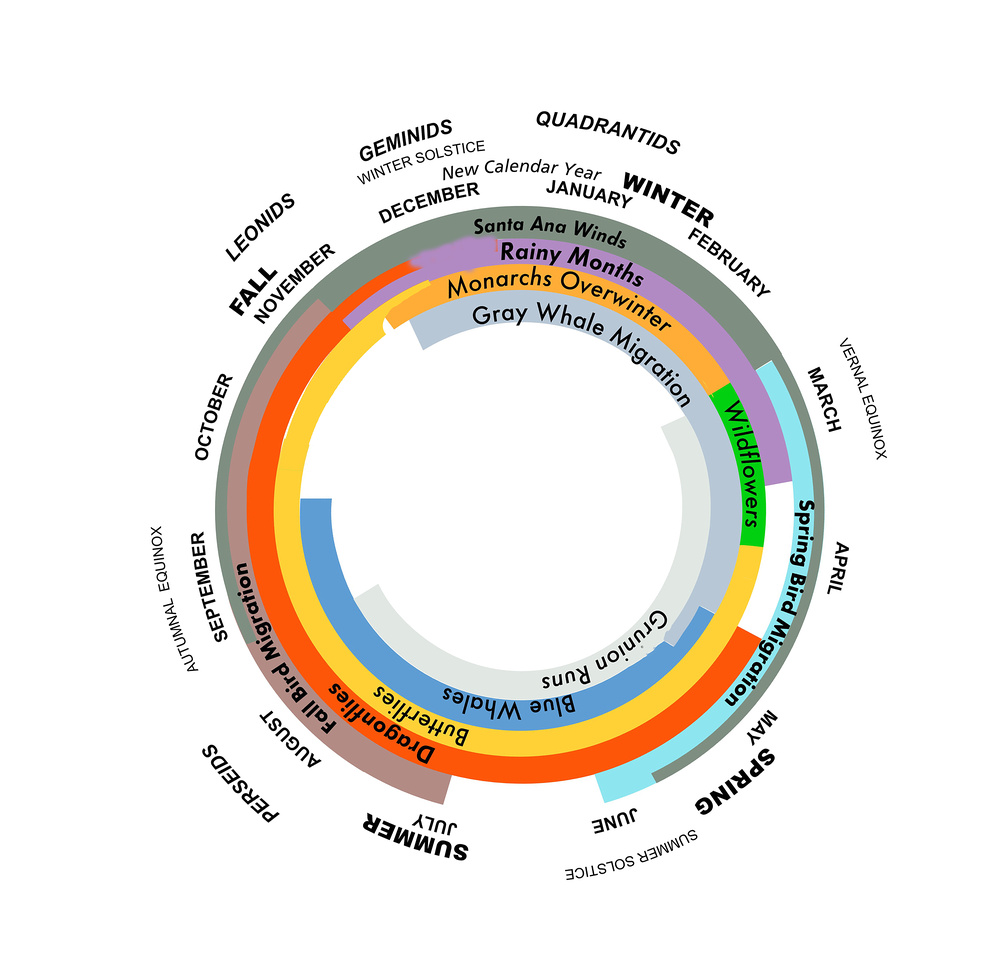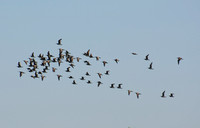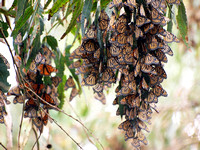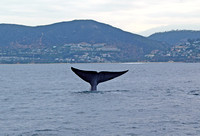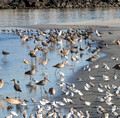Seasonal Events of Coastal Southern California
Seasons and the Calendar (download pdf)
The seasons are determined by the Earth’s orbit around the sun. Because the Earth’s axis is tilted at 23 ½ degrees relative to the plane of the orbit, daylight and nighttime lengths vary with the seasons. In the northern hemisphere, on the winter solstice, the north pole is in darkness the full 24 hours. The further north on the globe, the more hours of darkness. At summer solstice, the north pole is in sunlight the full 24 hours.
The assignment of months and names of seasons is a human designation that does not always reflect nature, but nature responds to changes in the light. Depending on where you are on Earth, your seasonal events will be different in terms of flora, fauna, and their timing.
These are seasonal events that may be of interest to many who enjoy nature.
Climate
They say, “April showers bring May flowers”. Well, ‘they’ aren’t from around here. That phrase originated in the U.K. and is perpetuated to places to which it does not apply. People also say that we live in a desert. Wrong again! Our deserts are in the rain shadow of the mountains. We live in a Mediterranean climate, with rainy winters and dry summers. Another phenomenon that impacts our weather is the Santa Ana winds. Originating in the desert, and funneled through the mountain passes, they are extremely strong, hot, and dry, and they drive down humidity. They can last a few days and occur periodically.
- Rainy months occur November through March
- Santa Ana Winds occur September through May, but occur most commonly in Autumn
Roughly 40% of birds migrate. Not all species migrate the same distance, direction, nor at the same time. Migration is far more complex than I am stating here, but some birds migrate long distances, some short distances, some to different latitudes, and some to different altitudes. In some cases, males, females, and young migrate at different times. While migration occurs in the spring and the fall, some species don’t just pass through our area; They stay for the entire winter or summer. And of course, we have many resident species that are here year-round, but they will mate, breed, and change plumage or song with the seasons.
Occasionally, some birds of a particular species leave earlier or later than their ‘scheduled’ time and are considered rare in our area because they are out of season. Occasionally a bird will migrate in the wrong direction and show up where it doesn’t belong. Birders are particularly fond of chasing these rarities.
- Spring migration: March to mid-June. Some birds may start to attempt to switch to their spring songs as early as late January. We, along with them, have to remember those songs again.
- Fall migration: Mid-July to Mid-November. Young birds will be making their way back along with returning adults. Plumages will vary considerably. Shorebirds will start in July and other birds in August.
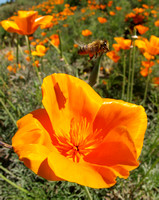 California poppy - Eschscholzia californica
California poppy - Eschscholzia californica Wildflowers
Wildflowers
California wildflowers have a short spring season where they go to seed quickly and don’t have to survive the hot summer. It may take a short drive to see the massive natural blooms, but locally, our native plant gardens will be blooming.
- Wildflower season peaks March through Mid-April
Different species of butterflies have different cycles. A brood is a single generation of butterflies, all of which fly during the same period. Some butterflies have a single brood per year, and some are multi -brooded. Many have two broods per year, one in the spring and another later in the fall. The broods align to the periods of the larval host plant.
Below are some times for best viewing of adults. They occur in small numbers to start, increasing to a peak, and then diminishing. Of course they may occur outside that range in smaller numbers.
- Butterflies numbers in general, peak Mid-April through Mid-Oct, but they may extend in small numbers until December.
- Monarch Butterflies overwinter at locations on the coast late November through February, while we have year-round resident populations, the numbers surge in winter when some migrate to our coasts.
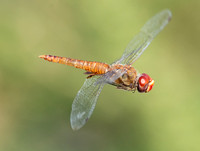 Spot-winged Glider - Pantala hymenaeaSpot-winged Glider - Pantala hymenaea Deforest Wetlands, 08/20/2018
Spot-winged Glider - Pantala hymenaeaSpot-winged Glider - Pantala hymenaea Deforest Wetlands, 08/20/2018 Dragonflies
Dragonflies
Young dragonflies live as nymphs in fresh water. They can take up to three years to mature. Additionally, some species migrate through our area.
- Dragonflies numbers in general, peak May through December with each species having its own peak months.
- Gray Whale Migration along our coast occurs in December through May. In December, January, and a little into February, the Whales are headed south to Mexico. A few may leave to head to Alaska in February, but the majority pass our coast in northward in March and April.
- Blue Whale peak viewing off our coast is May through September
- Grunion run March through August. April, May, and June are the peak months if you are looking for Grunion. The April run is best for bird watching as it aligns with peak shorebird migration. The morning after a grunion run can be a very interesting and birdy experience. Shorebirds are on the move and fueling up on the eggs.
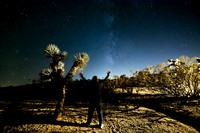 Self Portrait, Joshua Tree National Park
Self Portrait, Joshua Tree National Park Meteor Showers
Meteor Showers
Meteor showers occur when the Earth passes through comet debris that burns up in Earth’s atmosphere. Many of these meteor showers occur at the same time each year. Here are some of the more notable showers and when they occur.
- The Perseids occur in August
- The Geminids occur in December
- The Quadrantids occur in January
- The Leonids occur in November
Follow me on Facebook: https://www.facebook.com/KimMooreNaturalist/
